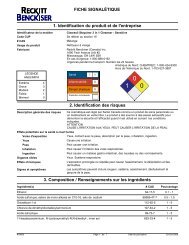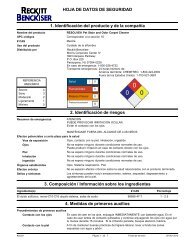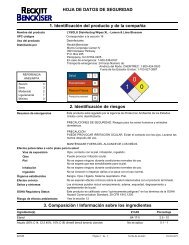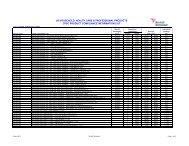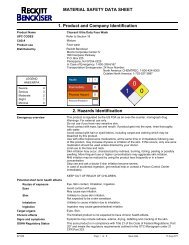Sustainability Report 2010.pdf - Reckitt Benckiser
Sustainability Report 2010.pdf - Reckitt Benckiser
Sustainability Report 2010.pdf - Reckitt Benckiser
Create successful ePaper yourself
Turn your PDF publications into a flip-book with our unique Google optimized e-Paper software.
Contents<br />
Introduction<br />
Environment<br />
Marketplace<br />
Workplace<br />
Community<br />
Managing & <strong>Report</strong>ing<br />
Reducing carbon through<br />
operational efficiency<br />
Energy use<br />
Since 2000, we have reduced energy<br />
consumption by 39% per unit of production<br />
and 16% in actual energy used.<br />
We used 0.56 Gigajoules (GJ) for every<br />
1,000 Consumer Units (CUs) of production<br />
in 2010. This was 5% lower than 2009.<br />
Our energy and production efficiency<br />
programmes are behind this improvement.<br />
For example:<br />
• Improving machine efficiency, insulating<br />
pipes and using natural lighting where<br />
possible at our site in Cali, Colombia,<br />
has increased energy efficiency by<br />
23% per unit of production.<br />
• At our facility in Milton, Canada we<br />
have made savings of 37% per unit of<br />
production by reducing heat output in<br />
the warehousing areas.<br />
p7 – RB’s climate change programme<br />
Air emissions<br />
Greenhouse gas emissions from energy use<br />
in manufacturing have fallen by 45% per unit<br />
of production since 2000, and total emissions<br />
are 25% lower.<br />
During 2010 we reduced these emissions<br />
by 11% per unit of production; down to<br />
0.043 tonnes of CO 2 per 1,000 CUs.<br />
Total emissions were 249,500 tonnes of<br />
CO 2 equivalent – 2% less than 2009.<br />
These emissions are generated directly on-site,<br />
through burning fossil fuels for space heating,<br />
hot water and process heating or cooling,<br />
and indirectly from our use of electricity.<br />
As well as improvements in energy efficiency<br />
we have made further GHG savings with new<br />
technologies and fuels:<br />
• Seven of our sites now use energy from<br />
combined heat and power (CHP) plants and<br />
seven use certified ‘green’ energy such as<br />
hydroelectricity or solar power.<br />
• We have replaced some high carbon fuels<br />
such as coal and furnace oil with biomass<br />
at our Hosur and Jammu sites in India and<br />
Semarang in Indonesia.<br />
Other emissions<br />
Common industrial air emissions such as<br />
sulphur and nitrous oxides (SOx and NOx)<br />
and particulates (dust) are not generally<br />
emitted from our manufacturing facilities.<br />
Where present, these emissions are below<br />
applicable legal requirements.<br />
At our facility in Semarang,<br />
Indonesia we have reduced our<br />
greenhouse gas emissions by over<br />
6,000 metric tons of CO 2 e since<br />
2009 by replacing the coal used for<br />
firing our boilers with biomass such<br />
as rice husks and saw dust. This is a<br />
59% reduction in greenhouse gas<br />
emissions from 2009 to 2010.<br />
Normalised energy use<br />
Normalised Energy Use<br />
Gigajoules (GJ) per 000’CUs<br />
Greenhouse gas<br />
Normalised Manufacturing Greenhouse Gas Emissions<br />
tonnes CO 2 equivalents per ‘000 CUs<br />
1.0<br />
0.8<br />
0.925<br />
0.08<br />
0.06<br />
0.0791<br />
0.6<br />
0.4<br />
0.595<br />
0.563<br />
0.04<br />
0.0485<br />
0.0432<br />
0.2<br />
0.02<br />
0.0<br />
00<br />
09<br />
10<br />
0.00<br />
00<br />
09<br />
10<br />
2010 Target = 20% reduction<br />
RB <strong>Sustainability</strong> <strong>Report</strong> 2010 7



